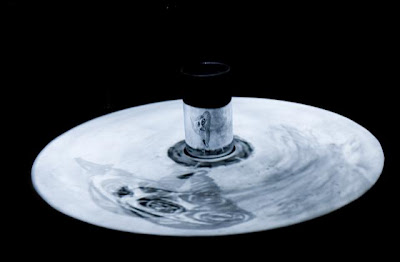Following on from her exhibition preview Isobel Johnston returns with this report on the Biennale, for real…
This year’s Biennale of Sydney is a demonstrably rigorous curated exhibition involving 180 artists over several physical locations and online. Not that didacticism per se is what I’m arguing for but the show works wonderfully as a teaching tool – a visually constructed academically tight means of being teleported back and forth through the canon of art history managing something rather greater than lip service to areas previously occluded. And here we’re talking peripheries and centres not just social, economical, racial etc but artistic – those that had been there but somehow eluded the art history books.

William Kentridge, What Will Come (Has Already Come), 2007.
35mm film transferred to video, 8:40 mins, 118 cm diameter
I haven’t seen everything but I’ve been taking various groups to the AGNSW, MCA and Cockatoo Island and Artspace and will be visiting Pier 2/3 in the coming weeks. Sight, sound and space all feature in this show and the use of Cockatoo Island for primarily video based works was a clever move as the site is and of itself overpoweringly charged – with massive industrial scale buildings, abandoned machinery and colonial history (not to mention very aggressive seagulls). The magic of encountering William Kentridge’s video pieces echoing back to social and politically states of being, silhouettes of nursery rhymes and Russian literature from the swirling anamorphic form to their syphoned reality creates a glimpse of how history works as they coalescence from the amorphous to the clearly visible.
The thing that might be seem to be missing in this Biennale is the ‘wow’ factor. But this is a hard thing to quantify and maybe if you hang around the arts for long enough you become a bit too jaded or just plain old. But I do remember having my socks knocked off by encountering works in past biennales – Nam June Paik’s TV sets, encountering Sophie Calle’s work , or Doris Salcedo’s shoes and it’s quite possible in the future I will recall Giuseppe Penone’s bronze tree, William Kentridge’s anamorphic animated drawings and participating in the Stuart Ringholt’s anger workshop. That was a strange encounter – one which I entered into rather sceptically and in retrospect considered more seriously. Historically there have been parallels and overlappings of art and hysteria or general madness, mentally instability- everybody loves a nutter like the Van Gogh or Louise Bourgeois or Mike Parr – you’d have to be a little strange or awfully sane to spend so many years exploring the threshold between the contained and the uncontained body – from vomit to piss. But apart from the few who really want to address this within their art and all those that reveal far more of it than they ever intended in their art practice but by and large we want to act fairly sane in public life. I had thought I’d just go through the motions and help the artist out by participating while remaining quite aloof from the whole process. But later in the day I experienced a kind of emotional backwash – though I’m not too sure what kind of public confession I really want to make here. Nonetheless I was forced to admit it did make me think.
Pierre Huyghe, A Forest of Line, 2008.
24 hour event in the Concert Hall at Sydney Opera House for the 16th Biennale of Sydney
So there may well be some lasting retinal retention – which is the best means I have of gauging the importance of a work- it’s almost like a slide show where I call recall works that really work for me in the mind’s eye – associated with this Biennale too where I can replay William Kentridge in my mind, recall the cold hug of the Pernone tree and see myself screaming caught in the carpeted space in the AGNSW or standing in a rainforest where the Opera House once stood.
I’ve yet to book in for a talk with Ross Gibson and may have left it too late. But I’m still recovering from ambushing Kentridge in the MCA where like a dag I said how much I liked his work. If I’d said anything else I’m sure he’d have been happy to continue a conversation but little else works better as a conversation stopper than a sycophantic opening line. But I gather that I wasn’t the only fool to corner him like that and in fact a groovy young arts person fessed up to saying not only did she tell him how much she liked his work she said “she squealed ‘oh my god it’s like meeting Picasso’.”
The great thing is that the Biennale is on for enough time to drift back to see work, to visit sites on different occasions and in the company of different people. This slower than usual experience of an exhibition adds to the audience’s engagement with both the works and the ideas. A sense of unfolding through time was felt in the Opera House’s main hall which had been converted into a forest of mist and tropical trees by French artist Pierre Huyghe. Reclaiming the foreshore like a drowned world may not be too far away if the climate change that is predicted happens but that idea of nature reclaiming ground especially in the tropics echoes through the work. Sound too lingers through the Biennale – it is a link to past and future times adding yet another dimension to recall. Take the ferry to Cockatoo Island it’s free, make sure you go back while it’s on to see the works that stirred you and take along a friend to share the memory with.
